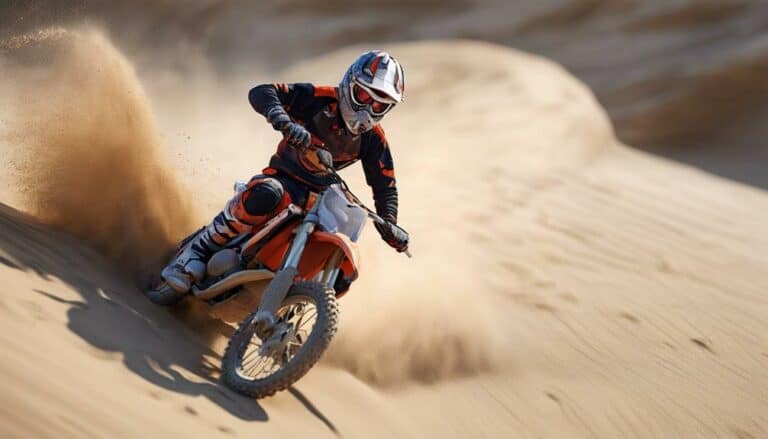When tackling sandy terrains, did you know that maintaining speed and momentum can be a challenging feat for off-road riders? By mastering the art of weight distribution, throttle control, and strategic body positioning, you can greatly enhance your performance on sandy surfaces.
These techniques not only boost your speed but also guarantee a smoother and more controlled ride through the shifting sands.
Want to discover the secrets to conquering sand dunes with finesse and precision?
Key Takeaways
- Lower tire pressure to 12-15 psi for better floatation and traction in sand.
- Maintain proper body position by leaning back and distributing weight evenly.
- Use gradual throttle control and strategic acceleration for building momentum.
- Choose lower gears, steady throttle, and avoid sudden stops to optimize speed in sandy terrain.
Tire Pressure and Traction Control
Lowering your tire pressure to around 12-15 psi is key to maximizing traction and control when riding off-road in sandy terrains. In soft sand, having the right tire pressure is like revealing a hidden weapon for your bike. By reducing the tire pressure, you increase the contact patch of the tire, allowing it to float on top of the sand rather than dig in. This improved flotation not only enhances grip but also prevents the tires from sinking into the sand, maintaining stability and speed.
With the perfect tire pressure, your bike will glide over the sand with ease, giving you the confidence to push your limits. The increased traction lets you maintain momentum, essential for handling sandy conditions. Remember, in sand riding, it's all about finding that ideal balance between grip and floatation. So, before you hit the dunes, make sure your tire pressure is set just right for an exhilarating off-road experience.
Body Position and Weight Distribution
Adjusting your body position and weight distribution plays a vital role in optimizing speed and momentum when moving through sandy terrain. To enhance your off-road riding experience in sand, consider the following:
- Leaning back: Shift your weight slightly towards the rear of the bike to keep the front wheel light, aiding in control and preventing sinking.
- Weight back: Shifting your weight to the rear of the bike can improve traction and stability in sandy conditions.
- Standing up: Riding while standing distributes weight more evenly, helping to maintain forward momentum and stability.
- Body positioning: Properly distributing your weight through body positioning is essential for enhancing speed, control, and stability on sandy surfaces.
Throttle Control and Acceleration Techniques
To enhance your control and optimize speed in sandy terrains, mastering throttle control and acceleration techniques is essential. When riding through sand, the way you handle your throttle can make a significant difference in your performance. Gradually increasing throttle input helps maintain speed and momentum without causing the wheels to dig into the sand. Utilize short bursts of acceleration strategically to prevent getting stuck in soft patches. Smooth and controlled throttle application is key to staying on top of the sand surface, ensuring a smoother ride. On straightaways, judicious use of acceleration can significantly boost your speed and momentum. Balancing power delivery with traction is crucial for progress in sandy conditions, helping you maintain control and achieve faster speeds. By mastering these techniques, you can confidently navigate sandy terrains with improved efficiency and speed.
| Throttle Control and Acceleration Techniques |
|---|
| Gradually increase throttle for momentum |
| Use short bursts of acceleration |
| Smooth throttle input for sand surface |
| Strategic acceleration on straightaways |
| Balancing power delivery with traction |
Choosing the Right Gear and Speed
When traversing through sandy terrains, making sure you choose the appropriate gear and maintain the best speed is paramount for maximizing control and performance. To improve your speed and momentum when riding through sand dunes, consider the following:
- Select the Right Gear: Choose a lower gear to keep your engine at high RPMs, preventing the bike from bogging down in the sand.
- Utilize Clutch Modulation: Use the clutch to control power delivery, preventing stalls in soft sand conditions.
- Maintain Steady Throttle Control: Keep a consistent speed with steady throttle control to ensure forward momentum.
- Avoid Sudden Stops: To prevent getting stuck in the sand and losing momentum, avoid abrupt speed changes.
Practice and Training for Sand Riding
Consider honing your sand riding skills through dedicated practice and targeted training to enhance your speed and momentum on off-road adventures.
To improve your performance in sandy terrain, focus on mastering throttle control to maintain consistent power delivery and generate speed.
Pay close attention to your body positioning and weight distribution, as these factors play an important role in optimizing traction and stability for faster riding in sand.
Selecting the right tires and adjusting the inflation levels can prevent your bike from bogging down and help you release its full speed potential on sandy surfaces.
Try standing up on the bike to reduce drag and increase your speed in soft sand.
Seeking guidance from experienced riders or trainers can provide valuable insights and techniques to refine your sand riding skills effectively.
Conclusion
Now that you've mastered the techniques for riding through sand, remember to embrace the challenge and let your skills shine like a well-oiled machine maneuvering through a desert oasis.
Keep your weight back, throttle steady, and eyes focused on the horizon. With practice and determination, you'll effortlessly glide through the sandy terrain like a seasoned off-road pro.
So rev up your engine, lean back, and conquer the sand dunes with confidence and finesse!

